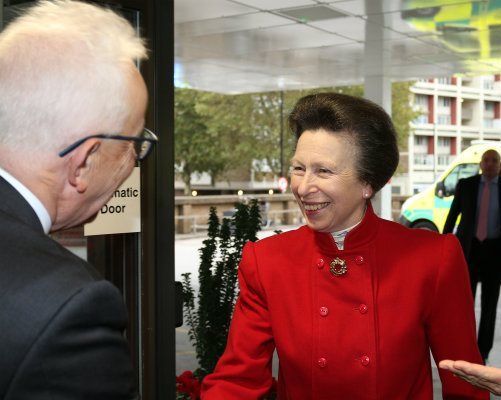New emergency department and short-stay unit opened by The Princess Royal
Posted on Wednesday 31st October 2018

The Princess Royal meeting Sir Hugh Taylor, Chair of Guy's and St Thomas' NHS Foundation Trust
The Princess Royal has opened a new emergency department at St Thomas' Hospital including Evelina London's dedicated children’s emergency department and short-stay unit for Evelina London patients.
On Tuesday 30 October, the emergency department (A&E) at St Thomas’ Hospital was officially opened by The Princess Royal after being completely rebuilt. It is one of the busiest emergency departments in the NHS with around 150,000 attendances a year (or 420 patients every day). That’s the equivalent of filling Wembley and Arsenal’s Emirates Stadium combined!
Her Royal Highness was given a tour of the department and met staff who ensured it remained open as normal, 24 hours a day, while the huge redevelopment was carried out. She heard how the project has transformed patient care by creating a dedicated Emergency Floor that brings together emergency services in a single area of the hospital.
Built by Logan Construction and designed by architects ADP, the new emergency department provides bigger treatment cubicles, better infection control and more privacy for patients and their families.
The emergency floor includes a dedicated children’s emergency department and children’s short-stay unit. This means Evelina London patients can be treated in a separate area from adult patients.
Dr John Criddle, consultant in paediatric emergency medicine at Evelina London, said: “Visiting an emergency department can be a frightening and intimidating experience for patients, especially children so having their own unit is very important. The art project and app are also great opportunities for us to help create a more relaxed and fun environment.”
“Sometimes children need to stay with us a little bit longer for treatment or observations. Rather than admitting them to Evelina London for such a short time, we’ve created a six-bed unit on the Emergency Floor for them. This makes it much easier for families and keeps beds free on the wards in the children’s hospital for children who need to stay longer.”
Dr Katherine Henderson, clinical lead for emergency medicine at Guy’s and St Thomas’, said: “I am incredibly proud of the new department and our dedicated staff so it was a real pleasure to show them both off to The Princess Royal.
“The old department was designed to see a maximum of 300 patients a day and we were treating an average of 380 patients a day when the rebuild started. Now we have a facility that means patients benefit from a brighter, more spacious environment and our staff will find it easier to deliver high quality care.”
A colourful design developed with art consultants, Art in Site, features a “family” of illustrated characters who act as friendly guides around the hospital. The family also come to life in an interactive app, playable on site, which helps to demystify the emergency process through interactive animations explaining clinical procedures, including blood tests, injections, and pulse measurements.
The Emergency Floor has delivered the following benefits for patients:
- New 62-bed admission ward with ensuite facilities
- New majors area with 25 treatment cubicles, a more efficient, open layout and improved facilities for staff and relatives
- Urgent Care Centre where patients with less serious conditions can be treated by GPs and emergency nurse practitioners
- New emergency department entrance, registration, assessment and waiting area
- New dedicated children’s emergency department and 6-bed Short Stay Unit
- Improved resuscitation area with larger treatment cubicles and dedicated trauma and isolation rooms
- Artwork funded by Guy’s and St Thomas’ Charity to create a welcoming environment and help patients navigate their way to the right area.
The collaboration between consultants Art in Site and architect ADP blends art, interior design and information together to bring better patient flow, orientation and a calming atmosphere – helping to reduce violence and aggression. It is based on insights from the Design Council publication Reducing violence & aggression in A&E: Through a better experience, which sought to improve both the patient and staff experience.